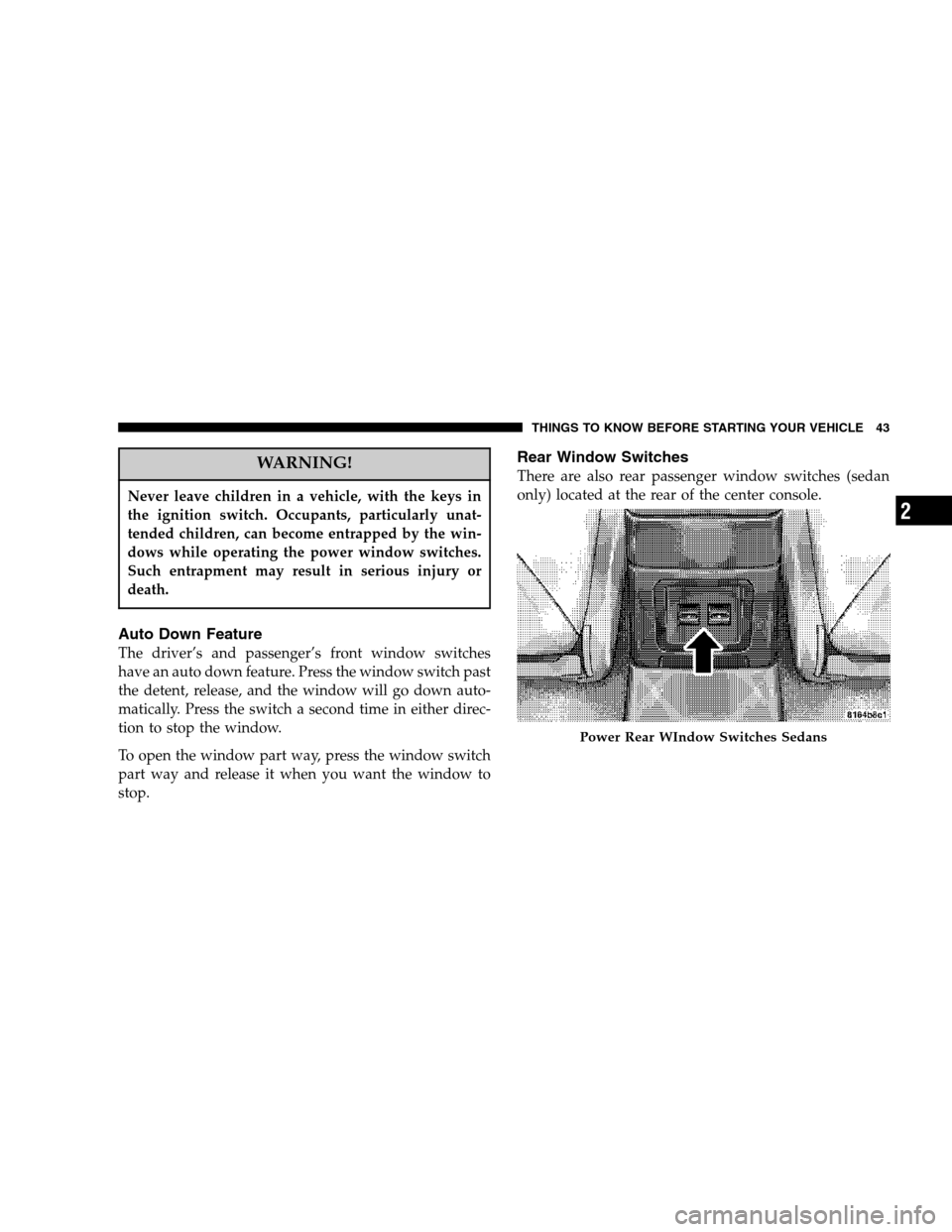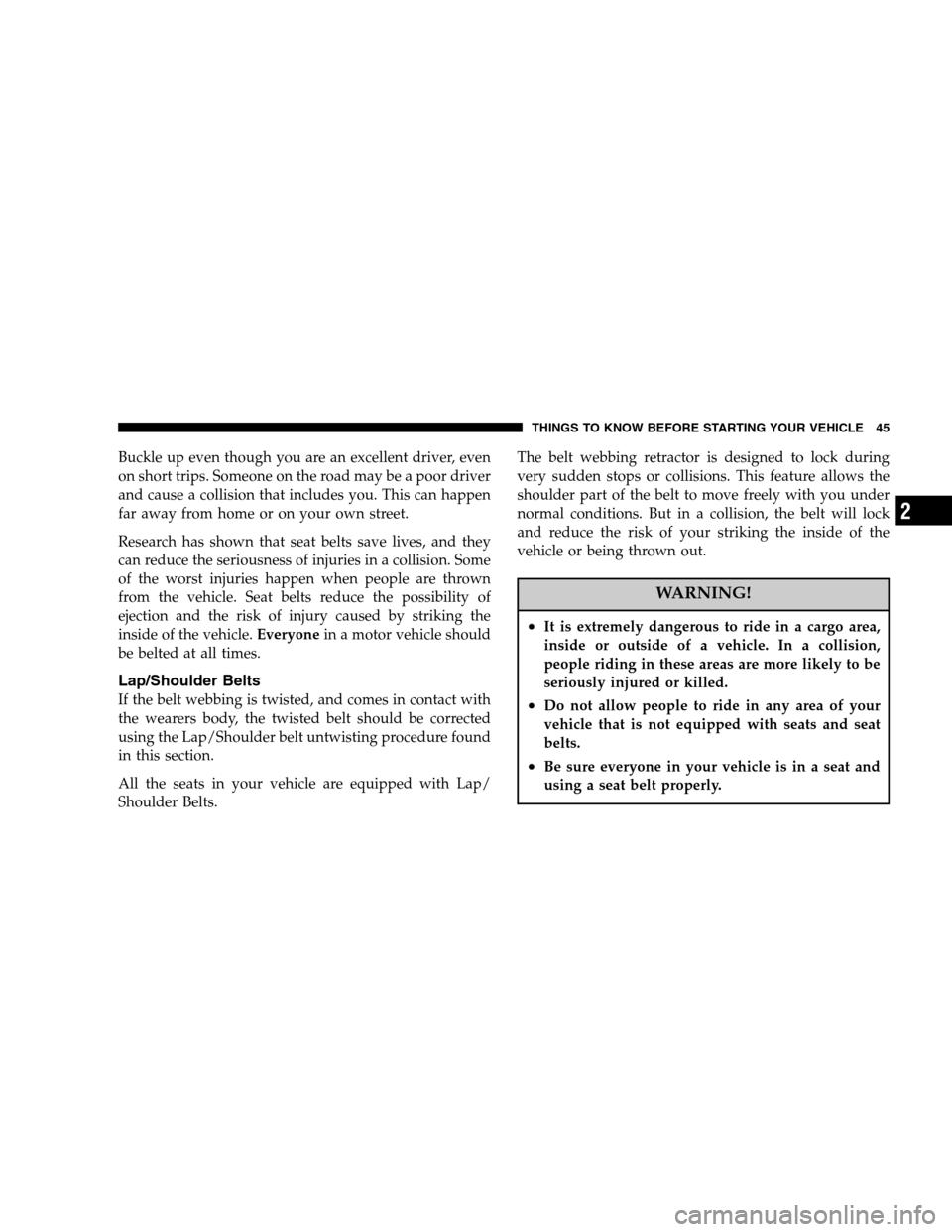stop start CHRYSLER PT CRUISER 2007 1.G Owners Manual
[x] Cancel search | Manufacturer: CHRYSLER, Model Year: 2007, Model line: PT CRUISER, Model: CHRYSLER PT CRUISER 2007 1.GPages: 458, PDF Size: 1.9 MB
Page 14 of 458

NOTE:If you try to remove the key before you place the
lever in PARK, the key may become trapped temporarily
in the ignition cylinder. If this occurs, rotate the key to the
right slightly, then remove the key as described. If a
malfunction occurs, the system will trap the key in the
ignition cylinder to warn you that this safety feature is
inoperable. The engine can be started and stopped but
the key cannot be removed until you obtain service.
WARNING!
Never leave children alone in a vehicle. Leaving
children in a vehicle unattended is dangerous for a
number of reasons. A child or others could be
seriously or fatally injured. Don’t leave the keys in
the ignition. A child could operate power windows,
other controls, or move the vehicle.
CAUTION!
An unlocked car is an invitation to thieves. Always
remove key from the ignition and lock all doors
when leaving the vehicle unattended.
Manual Transaxle—If Equipped
Turn the ignition switch to the ACC position, push the
key and cylinder inward, rotate the key to the LOCK
position, and remove the key.
Locking Doors With The Key
You can insert the key with either side up. To lock the
door, turn the key rearward, to unlock the door, turn the
key forward. See Section 7 of this manual for door lock
lubrication.
14 THINGS TO KNOW BEFORE STARTING YOUR VEHICLE
Page 17 of 458

Sentry Key Programming
You can program new keys to the system if you have two
valid sentry keys by performing the following procedure:
1. Cut the additional Sentry Key Transponder blank(s) to
match the ignition switch lock cylinder key code.
2. Insert the first valid key into the ignition switch and
turn the ignition switch ON for at least 3 seconds but no
longer than 15 seconds. Turn the ignition switch OFF and
remove the first key.
3. Insert the second valid key and turn the ignition
switch ON within 15 seconds. After ten seconds a chime
will sound and the Theft Alarm Light will begin to flash.
Turn the ignition switch OFF and remove the second key.
4. Insert a blank Sentry Key into the ignition switch and
turn the ignition switch ON within 60 seconds. After 10
seconds a single chime will sound. The Theft Alarm Light
will stop flashing, turn on for 3 seconds; then turn off.The new Sentry Key has been programmed.
Repeat this procedure to program up to a total of 8 keys.
If you do not have a programmed sentry key, contact
your dealer for details.
General Information
The Sentry Key system complies with FCC rules part 15
and with RSS-210 of Industry Canada. Operation is
subject to the following conditions:
•This device may not cause harmful interference.
•This device must accept any interference that may be
received, including interference that may cause undes-
ired operation.
THINGS TO KNOW BEFORE STARTING YOUR VEHICLE 17
2
Page 43 of 458

WARNING!
Never leave children in a vehicle, with the keys in
the ignition switch. Occupants, particularly unat-
tended children, can become entrapped by the win-
dows while operating the power window switches.
Such entrapment may result in serious injury or
death.
Auto Down Feature
The driver’s and passenger’s front window switches
have an auto down feature. Press the window switch past
the detent, release, and the window will go down auto-
matically. Press the switch a second time in either direc-
tion to stop the window.
To open the window part way, press the window switch
part way and release it when you want the window to
stop.
Rear Window Switches
There are also rear passenger window switches (sedan
only) located at the rear of the center console.
Power Rear WIndow Switches Sedans
THINGS TO KNOW BEFORE STARTING YOUR VEHICLE 43
2
Page 45 of 458

Buckle up even though you are an excellent driver, even
on short trips. Someone on the road may be a poor driver
and cause a collision that includes you. This can happen
far away from home or on your own street.
Research has shown that seat belts save lives, and they
can reduce the seriousness of injuries in a collision. Some
of the worst injuries happen when people are thrown
from the vehicle. Seat belts reduce the possibility of
ejection and the risk of injury caused by striking the
inside of the vehicle.Everyonein a motor vehicle should
be belted at all times.
Lap/Shoulder Belts
If the belt webbing is twisted, and comes in contact with
the wearers body, the twisted belt should be corrected
using the Lap/Shoulder belt untwisting procedure found
in this section.
All the seats in your vehicle are equipped with Lap/
Shoulder Belts.The belt webbing retractor is designed to lock during
very sudden stops or collisions. This feature allows the
shoulder part of the belt to move freely with you under
normal conditions. But in a collision, the belt will lock
and reduce the risk of your striking the inside of the
vehicle or being thrown out.
WARNING!
•It is extremely dangerous to ride in a cargo area,
inside or outside of a vehicle. In a collision,
people riding in these areas are more likely to be
seriously injured or killed.
•Do not allow people to ride in any area of your
vehicle that is not equipped with seats and seat
belts.
•Be sure everyone in your vehicle is in a seat and
using a seat belt properly.
THINGS TO KNOW BEFORE STARTING YOUR VEHICLE 45
2
Page 48 of 458

WARNING!
•A belt that is buckled into the wrong buckle will not
protect you properly. The lap portion could ride too high
on your body, possibly causing internal injuries. Always
buckle your belt into the buckle nearest you.
•A belt that is too loose will not protect you as well. In
a sudden stop you could move too far forward, increasing
the possibility of injury. Wear your seat belt snugly.
•A belt that is worn under your arm is very dangerous.
Your body could strike the inside surfaces of the vehicle
in a collision, increasing head and neck injury. A belt
worn under the arm can cause internal injuries. Ribs
aren’t as strong as shoulder bones. Wear the belt over
your shoulder so that your strongest bones will take the
force in a collision.
•A shoulder belt placed behind you will not protect you
from injury during a collision. You are more likely to hit
your head in a collision if you do not wear your shoulder
belt. The lap and shoulder belt are meant to be used
together.
4. Position the lap belt across your thighs, below your
abdomen. To remove slack in the lap belt portion, pull up
on the shoulder belt. To loosen the lap belt if it is too tight,
tilt the latch plate and pull on the lap belt. A snug belt
reduces the risk of sliding under the belt in a collision.
Removing Slack From Belt
48 THINGS TO KNOW BEFORE STARTING YOUR VEHICLE
Page 74 of 458

•If the belt still can’t be tightened, or if by pulling and
pushing on the restraint loosens the belt, disconnect
the latch plate from the buckle, turn the latch plate
around, and insert the latch plate into the buckle
again. If you still can’t make the child restraint secure,
try a different seating position.
•Buckle the child into the seat according to the child
restraint manufacturer’s directions.
•When your child restraint is not in use, secure it in the
vehicle with the seat belt or remove it from the vehicle.
Don’t leave it loose in the vehicle. In a sudden stop or
collision, it could strike the occupants or seat backs
and cause serious personal injury.
Automatic-Locking Retractor (ALR)
To operate the switchable retractor, pull the belt from the
retractor until there is enough to allow you to pass
through the child restraint and slide the latch plate into
the buckle. Then pull on the belt until it is all removedfrom the retractor. Allow the belt to return into the
retractor, pulling on the excess webbing to tighten the lap
portion about the child restraint. Follow the instructions
of the child restraint manufacture.
NOTE:To reset this feature you must let all of the belt
webbing return into the retractor. You will not be able to
pull out more webbing until all of the webbing has been
returned back into the retractor.
Lower Anchors and Tether for CHildren (LATCH)
Your vehicle is equipped with the child restraint anchor-
age system called LATCH, which stands for Lower
Anchors and Tether for CHildren. The LATCH system
provides for the installation of the child restraint without
using the vehicle seat belt. All three rear seating positions
have lower and tether anchorages that are capable of
accommodating LATCH-compatible child seats having
flexible, webbing-mounted lower attachments. Child
seats with fixed lower attachments must be installed in
74 THINGS TO KNOW BEFORE STARTING YOUR VEHICLE
Page 80 of 458

Lap/Shoulder Belts
All the seats in your vehicle are equipped with Lap/
Shoulder Belts.
If the belt webbing is twisted, and comes in contact with
the wearers body, the twisted belt should be corrected
using the Lap/Shoulder belt untwisting procedure found
in this section.
The belt webbing retractor is designed to lock during
very sudden stops or collisions. This feature allows the
shoulder part of the belt to move freely with you under
normal conditions. But in a collision, the belt will lock
and reduce the risk of your striking the inside of the
vehicle or being thrown out.WARNING!
•It is extremely dangerous to ride in a cargo area,
inside or outside of a vehicle. In a collision,
people riding in these areas are more likely to be
seriously injured or killed.
•Do not allow people to ride in any area of your
vehicle that is not equipped with seats and seat
belts.
•Be sure everyone in your vehicle is in a seat and
using a seat belt properly.
80 THINGS TO KNOW BEFORE STARTING YOUR VEHICLE
Page 82 of 458

3. When the belt is long enough to fit, insert the latch
plate into the buckle until you hear a “click.”WARNING!
•A belt that is buckled into the wrong buckle will not
protect you properly. The lap portion could ride too high
on your body, possibly causing internal injuries. Always
buckle your belt into the buckle nearest you.
•A belt that is too loose will not protect you as well. In a
sudden stop you could move too far forward, increasing
the possibility of injury. Wear your seat belt snugly.
•A belt that is worn under your arm is very dangerous.
Your body could strike the inside surfaces of the vehicle in
a collision, increasing head and neck injury. A belt worn
under the arm can cause internal injuries. Ribs aren’t as
strong as shoulder bones. Wear the belt over your shoul-
der so that your strongest bones will take the force in a
collision.
•A shoulder belt placed behind you will not protect you
from injury during a collision. You are more likely to hit
your head in a collision if you do not wear your shoulder
belt. The lap and shoulder belt are meant to be used
together.Latch Plate To Buckle
82 THINGS TO KNOW BEFORE STARTING YOUR VEHICLE
Page 107 of 458

into the retractor, as the belt retracts, you will hear a
clicking sound. This indicates that the seat belt is now in
the automatic locking mode. Pull on the excess webbing
to tighten the lap portion about the child restraint. Follow
the instructions of the child restraint manufacture.
NOTE:To reset this feature you must let all of the belt
webbing return into the retractor. You will not be able to
pull out more webbing until all of the webbing has been
returned back into the retractor.
•In the rear seat, you may have trouble tightening the
lap/shoulder belt on the child restraint because the
buckle or latch plate is too close to the belt path
opening on the restraint. Disconnect the latch plate
from the buckle and twist the short buckle end of the
belt several times to shorten it. Insert the latch plate
into the buckle with the release button facing out.
•If the belt still can’t be tightened, or if by pulling and
pushing on the restraint loosens the belt, disconnectthe latch plate from the buckle, turn the latch plate
around, and insert the latch plate into the buckle
again. If you still can’t make the child restraint secure,
try a different seating position.
•Buckle the child into the seat according to the child
restraint manufacturer’s directions.
•When your child restraint is not in use, secure it in the
vehicle with the seat belt or remove it from the vehicle.
Don’t leave it loose in the vehicle. In a sudden stop or
collision, it could strike the occupants or seat backs
and cause serious personal injury.
Lower Anchors and Tether for CHildren (LATCH)
Your vehicle is equipped with the child restraint anchor-
age system called LATCH, which stands for Lower
Anchors and Tether for CHildren. The LATCH system
provides for the installation of the child restraint without
using the vehicle seat belt. Both rear seating positions
have exclusive lower anchorages located at the rear of the
THINGS TO KNOW BEFORE STARTING YOUR VEHICLE 107
2
Page 226 of 458

21. Oil Pressure Light
Shows low engine oil pressure. The light will come
on and remain on when the ignition switch is
turned from the OFF to the ON position, and the light
will turn off after the engine is started. If the bulb does
not come on during starting, have the system checked by
an authorized dealer.
If the light comes on and remains on while driving, stop
the vehicle and shut off the engine. DO NOT OPERATE
THE VEHICLE UNTIL THE CAUSE IS CORRECTED.
The light does not show the quantity of oil in the engine.
This can be determined using the procedure shown in
Section 7. (See page 363 for more information.)
22. High Beam Indicator
This light shows that the headlights are on high
beam. Pull the turn signal lever toward the steer-
ing wheel to switch the headlights from high or low
beam.23. Electronic Vehicle Information Center Display—If
Equipped
When the appropriate conditions exist, this display
shows the Electronic Vehicle Information Center (EVIC)
messages. (See page 227 for more information.)
24. Odometer/Trip Odometer Reset Knob
Press this button to change the display from odometer to
either of the two trip odometer settings. Trip A or Trip B
will appear when in the trip odometer mode. Push in and
hold the button for two seconds to reset the trip odometer
to 0 miles or kilometers. The odometer must be in trip
mode to reset.
25. Electronic Vehicle Information Center (EVIC)
Button—If Equipped
Pushing this button will switch between the different
EVIC functions. (See page 227 for more information.)
226 UNDERSTANDING YOUR INSTRUMENT PANEL